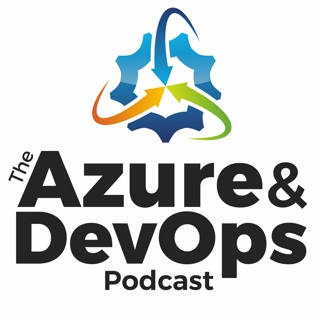
Jeff Fritz: Evolving Cloud Architecture - Episode 222
Jeff Fritz is an experienced developer, technical educator, and PM on the .NET team at Microsoft. He founded The Live Coders team on Twitch, and regularly livestreams builds of websites and fun applications. You can follow Jeff for more .NET, .NET Core, and Visual Studio content on Twitch and Twitter at @csharpfritz. Topics of Discussion: [2:41] Jeff talks about surviving the .com bomb and his background as a longtime web developer and technical educator. [3:57] What have been some of the recent developments that Jeff and his team are most excited about at Microsoft? [5:45] Jeff talks about how the application has been growing and how he's had some bumps in the road. [7:40] How to make video clips searchable and discoverable on the web. [12:12] What made Jeff go for MySQL instead of serverless Azure SQL? [18:01] What's the duration of the journey from the first line of code to enterprise patterns? [21:09] As we grow applications, we need to figure out a better way to show people what happens when you make a mistake, and to help them through the growth. [27:13] How do you know what's going to happen at a certain level of production? [22:48] Does Jeff really believe we're going to end up at Kubernetes? [32:27] Re-architecting your database architecture. Mentioned in this Episode: Architect Tips — New video podcast! Azure DevOps Clear Measure (Sponsor) .NET DevOps for Azure: A Developer's Guide to DevOps Architecture the Right Way, by Jeffrey Palermo — Available on Amazon! Jeffrey Palermo's YouTube Jeffrey Palermo's Twitter — Follow to stay informed about future events! Programming with Palermo programming@palermo.network Jeff on Twitch KlipTok Fritz's Tech Tips and Chatter Want to Learn More? Visit AzureDevOps.Show for show notes and additional episodes.
5 Joulu 202236min

Brady Gaster: Orleans - Episode 221
Brady is a Principal Program Manager on the Azure Developer Experience team at Microsoft where he works on Orleans, SignalR, microservices, APIs, and integration with Azure service teams in hopes to make it exciting for developers who work on .NET apps to party in the cloud! Topics of Discussion: [4:17] Moving around a lot gave Brady a lot of insight into all the different ways that we can benefit developers and all the different opportunities we have to make things better. [6:30] The people in Docs hack all the time. [7:01] What is Orleans? [11:40] What's the best database to use for distributed applications? [21:10] Open telemetry gives us the capability of being able to trace messages that go from one end of your system all the way to the other end of your system through multiple silos and multiple clients. [22:08] The three pillars of observability: logging, distributed tracing (which is really where open telemetry shines), and then metrics. [26:02] How does the traceability side of open telemetry apply to Azure? [28:02] What else should we know about Orleans? Mentioned in this Episode: Architect Tips — New video podcast! Azure DevOps Clear Measure (Sponsor) .NET DevOps for Azure: A Developer's Guide to DevOps Architecture the Right Way, by Jeffrey Palermo — Available on Amazon! Jeffrey Palermo's YouTube Jeffrey Palermo's Twitter — Follow to stay informed about future events! Programming with Palermo programming@palermo.network "Brady Gaster on SignalR and More" Brady Gaster Brady Gaster GitHub Brady Gaster Rock Paper Orleans Brady Gaster Website Want to Learn More? Visit AzureDevOps.Show for show notes and additional episodes.
28 Marras 202231min

Matthew Renze: Developing Your AI Strategy - Episode 220
Matthew Renze is a data science consultant, author, and public speaker. He is the founder of Renze Consulting, an AI consulting company that has trained over 400,000 software developers and IT professionals. His clients range from small tech start-ups to Fortune 500 companies. He is also the President of Serenze Global, a 501(c)(3) non-profit organization dedicated to improving access to technology education for under-represented individuals by empowering the next generation of tech community leaders. Matthew is currently working on his Master's degree in Artificial Intelligence with a Data Science specialization at Johns Hopkins University. He currently has double degrees in Computer Science and Philosophy with a minor in Economics from Iowa State University. He is a Microsoft MVP in AI, an ASPInsider, and an author for Pluralsight, Udemy, and Skillshare. His interests include AI, ML, data science, mindfulness, technology education, and tech community leadership. Topics of Discussion: [3:37] How Matthew got into software development and rebranded himself as a data science consultant before going independent as a consultant. Now, he is in the process of rebranding as an AI consultant, rather than a data science consultant, still with a foundation in data science. [4:41] What exactly is AI? [6:23] Matthew discusses what a traveling salesman is. [9:15] Matthew sorts out the difference between AI and ML for us. [10:35] Artificial intelligence typically includes a bunch of other tools, in addition to machine learning. [11:11] We now have more enhanced versions of machine learning that fall under the umbrella of AI, like deep learning, and reinforcement learning, which are all built on top of the idea of machine learning. [12:12] What are the levels of education that should exist within an organization? [14:49] What can be automated now that used to not be able to be automated? [19:03] How GitHub co-pilot can help. [20:14] What is an AI Factory, and why are people arguing over it? [21:32] If we can eliminate our busy work, we can essentially get models built quicker, get data science done quicker, and get things automated quicker. [22:20] The DevOps platform. [27:40] One of the biggest questions that remain with AI is if we end up with more jobs created as a result of artificial intelligence than are eliminated by it. [31:32] Okay, let's say how to pronounce data correctly. Mentioned in this Episode: Architect Tips — New video podcast! Azure DevOps Clear Measure (Sponsor) .NET DevOps for Azure: A Developer's Guide to DevOps Architecture the Right Way, by Jeffrey Palermo — Available on Amazon! Jeffrey Palermo's YouTube Jeffrey Palermo's Twitter — Follow to stay informed about future events! Programming with Palermo programming@palermo.network "Matthew Renze on Data Science for Developers" Matthew Renze Competing in the Age of AI: Strategy and Leadership When Algorithms and Networks Run the World, by Marco Iansiti Karim R. Lakhani Want to Learn More? Visit AzureDevOps.Show for show notes and additional episodes.
21 Marras 202233min

Donovan Brown: Microservices DevOps - Episode 219
Donovan Brown is a Partner Program Manager in the Azure CTO Incubations team at Microsoft. The Incubations team focuses on forward-looking development and innovation to facilitate the development of new projects and ideas. Before joining Microsoft, Donovan spent seven years as a Process Consultant and a Certified Scrum Master. Donovan has traveled the globe helping companies develop solutions using agile practices in many industries. Donovan is an avid programmer, often finding ways to integrate software into his other hobbies and activities. Topics of Discussion: [3:02] Donovan talks about the high points of his career and what led him to work in the Azure CTO incubations team at Microsoft. [7:14] What are the differences in a DevOps environment for microservices from an interior application? [9:49] There can be pure and perfect pipelines for microservices, but there's a whole bunch of gray there. [12:25] Microservices are as small as they can be but no smaller. [14:22] Donovan shares that what he is thinking about is which of these do I need to scale independently of everything else, and how can he then write it in such a way that it works. [18:44] Donovan shares why he calls himself "test aware." [25:57] How do you decide if a microservice needs to scale separately from the rest of the application? [31:02] When Donovan thinks of Web3, the first thing that pops into his mind is blockchains. [32:18] To Donovan, the technology is about the blockchain that underlies it, the ability to write smart contracts that live on that blockchain, and being able to democratize a lot of things that today are centralized through the people who do our authentication for us and who own our data. [34:53] What's the current state of DevOps, and where are we on the Web3 curve? Donovan talks about the need to educate yourself about it, and to make sure you listen to a diversity of opinions. [41:35] NFTs can actually be used for really clever use cases that a lot of people just haven't seen yet. Mentioned in this Episode: Architect Tips — New video podcast! Azure DevOps Clear Measure (Sponsor) .NET DevOps for Azure: A Developer's Guide to DevOps Architecture the Right Way, by Jeffrey Palermo — Available on Amazon! Jeffrey Palermo's YouTube Jeffrey Palermo's Twitter — Follow to stay informed about future events! Programming with Palermo programming@palermo.network How to Use Azure DevOps Services with Donovan Brown DevOps for Web3 series Donovan Brown at MS Ignite 2022 Want to Learn More? Visit AzureDevOps.Show for show notes and additional episodes.
14 Marras 202244min

Dave McKinstry: The Evolution of DevOps - Episode 218
Dave McKinstry. Dave is a Director at GitHub helping to drive the FastTrack program. Prior to GitHub, he worked as a Program Manager with the Azure DevOps Services Community Team — connecting with partners and customers, spreading modern practices, and helping developers succeed with DevOps and Azure. Prior to his position at Microsoft, he has been in software services and technical sales for over 30 years. As a consultant, principal consultant, co-owner, and manager, he has always helped people efficiently build better software. He loves what he does as a technologist and enjoys being a part of today's rapid technology evolution. Topics of Discussion: [3:05] Dave talks about getting into consulting, and then finding his way to Azure DevOps before joining Microsoft, and ultimately GitHub. [4:27] What is the difference between Microsoft and GitHub? How do they do things differently? [7:57] The evolution of DevOps and how it has evolved over time from the start to now. [9:53] Why DevSecOps is redundant. Security has to be part of everything we do. So security is every engineer and every product owner. For anyone working in your company, security is part of their job. [11:00] Dave discusses Inner Source. [15:05] Having cultural trust is extremely important. Can you trust the people that you have working for you to do the best work they can for your organization? If the answer is no, there are probably other problems, other things to worry about. [16:08] You can see the code of anything external that's been shared, but there are a lot of organizations with multiple software teams who just don't automatically give their own employees even read access to the repositories of the other team. [21:50] Microsoft has kind of done some things to strengthen GitHub, like hosted build agents and others, and then GitHub does things that strengthen Microsoft. [30:05] Where does Dave think the industry is headed in the future? [31:51] Regardless of how big the company is, developers should be better empowered. [32:03] Plug for GitHub Universe. Mentioned in this Episode: Architect Tips — New video podcast! Azure DevOps Clear Measure (Sponsor) .NET DevOps for Azure: A Developer's Guide to DevOps Architecture the Right Way, by Jeffrey Palermo — Available on Amazon! Jeffrey Palermo's YouTube Jeffrey Palermo's Twitter — Follow to stay informed about future events! Programming with Palermo programming@palermo.network Dave McKinstry on Integrating Azure DevOps and the Culture of DevOps - Episode 005 GitHub GitHub Universe Want to Learn More? Visit AzureDevOps.Show for show notes and additional episodes.
7 Marras 202233min

Nicholas Blumhardt: Structured Logging - Episode 217
Nicholas Blumhardt is the Founder/CEO at @datalust_seq, core maintainer for #Serilog, founder of @AutofacIoC, and long-ago .NET PM at Microsoft. He resides in Brisbane, Australia. Topics of Discussion: [2:25] Nicholas talks about what got him into structured logging. [7:09] As a consultant, what surprised Nicholas about structured logging? [7:57] Rather than just being able to easily pass the logs that he was already writing, Nicholas could think about building something that was more like a developer interface for the app. [10:07] A lot of people associate the tooling and technology with DevOps, but if you dig back into why we originally set out on that path, it was much more about the practices. [11:10] Building your systems so that they are easier to run and diagnose issues is really where it's at. [12:25] Structured logging is just one tool in the tool belt to achieve observability. [13:54] What other tools does Nicholas use to gain observability? [17:09] What is Serilog and how does it serve as an interface for structured logging? [29:51] Why is Seq useful and why should listeners give it a try? Mentioned in this Episode: Architect Tips — New video podcast! Azure DevOps Clear Measure (Sponsor) .NET DevOps for Azure: A Developer's Guide to DevOps Architecture the Right Way, by Jeffrey Palermo — Available on Amazon! Jeffrey Palermo's YouTube Jeffrey Palermo's Twitter — Follow to stay informed about future events! Programming with Palermo programming@palermo.network Nicholas Blumhardt Twitter Autofac Website Autofac Serilog Seq Nicholas Blumhardt Website nblumhardt@nblumhardt.com
31 Loka 202236min

Isaac Abraham: Farmer for Azure Deployments - Episode 216
Isaac Abraham is an. NET MVP and a .NET developer since .NET 1.0 with an interest in cloud computing and distributed data problems. He is the author of Get Programming with F# and is the director of Compositional IT. He specializes in consultancy, training, and development, helping customers adopt high-quality, functional-first solutions on the .NET platform. Topics of Discussion: [3:12] Isaac talks about getting into Software Dev, how he sought to work in a small space where he could learn hands-on about .NET development, and how he has been doing that ever since. [4:22] How has the landscape changed? [5:00] Isaac got into Azure during the early days. [6:59] How is consulting different? [13:20] What exactly is Farmer, and how do we use it? [16:44] Does it matter which .NET language the nougat package is pulled into? [18:29] An F# project can exist nicely in a Visual Studio solution with other C# projects. [19:59] With Isaac's unabashed opinion on Farmer, does he prefer having one project that has all of the infrastructure code for both with all the components that are deployed in the application, or does he prefer referencing pharma from the different applications and distributing that logic? [29:48] Isaac does use Azure Client, but ironically, it's only to deploy the templates that Farmer generates. Mentioned in this Episode: Architect Tips — New video podcast! Azure DevOps Clear Measure (Sponsor) .NET DevOps for Azure: A Developer's Guide to DevOps Architecture the Right Way, by Jeffrey Palermo — Available on Amazon! Jeffrey Palermo's YouTube Jeffrey Palermo's Twitter — Follow to stay informed about future events! Programming with Palermo programming@palermo.network The Cockney Coder Isaac Abraham FarmerCompositional IT isaac@compositional-it.com Isaac's Twitter Get Programming with F#: A guide for .NET developers Want to Learn More? Visit AzureDevOps.Show for show notes and additional episodes.
24 Loka 202235min

Ted Neward: Getting the Most Out of In-Person Conferences - Episode 215
Ted is a self-described geek who takes great pride and joy in making other geeks into bigger and better (and hopefully more highly rewarded) geeks. Having recently stepped into a management role, Ted has been looking for more and more ways to leverage his skills as a "force multiplier" across his entire team to not only better the team itself — but the entire organization as a whole. Topics of Discussion: [5:04] Microsoft is probably going to look for ways to do the summit in person, but the pandemic has shown us we can also use remote options for those that don't want to or can't travel. [6:14] Ted discusses some tools that make getting the information at conferences easier and more accessible. [13:15] We all want to find that tribe; to find that group of people where we feel like we fit in. [23:10] Ted talks about why he doesn't love that a lot of conferences are kind of trying to combine professional development and family vacation. [25:10] Remember that you are at a professional event, and you represent your company. Don't lose sight of why you are there. [28:20] What Ted has been playing with these days. [34:56] The problem with low-code solutions is that they're designed for hobbyists. [40:26] The emergence of low-code and no-code tools. Mentioned in this Episode: Architect Tips — New video podcast! Azure DevOps Clear Measure (Sponsor) .NET DevOps for Azure: A Developer's Guide to DevOps Architecture the Right Way, by Jeffrey Palermo — Available on Amazon! Jeffrey Palermo's YouTube Jeffrey Palermo's Twitter — Follow to stay informed about future events! Programming with Palermo programming@palermo.network Episode 135 http://www.lolcode.org/ — lolcode: transpiler, compiler https://github.com/justinmeza/lci https://ballerina.io/ http://www.cs.uni.edu/~okane/source/MUMPS-MDH/MumpsTutorial.pdf Want to Learn More? Visit AzureDevOps.Show for show notes and additional episodes.
17 Loka 202248min





















